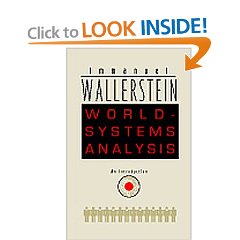
The big eye-opener for me was that “World Systems” is NOT the same as Whole Systems. World Systems is entirely anthropomorphic and addresses the inter-relationships among forms of human organization, with the state and the marketplace/capitalism being the primary focus.
The heart of the book is found on page 88 after a very fine lead-up that explains the three competing human ideologies of conservativism, liberalism, and radicalism (anti-system).
QUOTE: “The key element of the debate is the degree to which any social system, in this case the future one we are constructing, will lean in one direction or the other on two long-standing central issues of social organization–liberty and equality–issues that are more closely intertwined than social though in the modern world-system has been willing to assert.”
My notes from this rewarding read:
+ Science and philosophy did not part until the mid-18th century, they have been two cultures in conflict since then. See Voltaire's Bastards: The Dictatorship of Reason in the West.
+ In the 19th century both split further (philosophy-humanities spinning off social sciences that remain moribund and unable to deal with a tough hybrid problem, “social reality”
+ The French Revolution spawned the social sciences in that it introduced the concept of public sovereignty, replacing “subjects” with “citizens,” and creating a puzzle still not fully understood.
+ History has valued the scientific method, but tended to stay closer to the humanities. Who writes history matters–up to this point, history has generally been written within five Western nations, and tended to assume that indigenous tribes lack “history” which is erroneous.
+ Western approach to the non-western was to divide between “Orientalists” and anthropologists, the first studying China and “the East” while the second studied indigenous tribes in their CURRENT condition, assuming that nothing from their past was relevant. See 1491: New Revelations of the Americas Before Columbus for the more righteous understanding.
+ The tendency of all “scholars” has been to study differences (the 20%) rather than generic commonalities (the 80%).
+ 1945 and the Cold War led to the 3rd world being a battleground (the author does not venture into “High Cabal” arena or the military-industrial complex) and also led to an explosion in higher education (GI Bill) and consequently a massive fragmentation of knowledge as area studies proliferated to meet the PhD need for “originality.”
+ 1945-1970 saw four “debates”
—Core-periphery and dependency, the first focusing on the unequal trade between the Western core and the periphery nations, the second focusing on corporate predation. See Global Reach: The Power of the Multinational Corporations from the 1970's and more recently Confessions of an Economic Hit Man.
—Marxist discussion of the Asiatic mode of production (neither communism nor capitalism)
—Transition from feudalism to capitalism (which is all consuming and NOT to be confused with a free and fair marketplace)
—“Total history,” the Annales group in France, a holistic approach to anthropomorphism
INPORTANT: Structure of knowledge impacts on what you know, how you know
1968 was a revolution in human affairs, with student and labor and other protesters focused on university support of the status quo, the neglect of oppressed groups, and the need to break down barriers. See Weapons of Mass Instruction: A Schoolteacher's Journey through the Dark World of Compulsory Schooling.
The balance of the book is about world empires (state dominates) versus world economies (capitalism dominates), with three types of economics: reciprocal, redistributive (rich take from the poor and concentrate wealth), and market (theoretical)..
There is a good discussion of data and the need to FIND data, not just study the problems for which data is easily available.
QUOTE: “TimeSpaces are constantly constructed realities whose construction is part and parcel of the social reality we are analyzing.”
Author defines capitalism as the system that gives priority to the ENDLESS ACCUMULATION of capital, and observes that the multiplicity of states and corporations is needed to give capitalists the wiggle room to secure advantage.
5 kinds of income: wage, subsistence, petty commodity, rent, transfer payments.
3 kinds of externalization of cost to society: toxicity, exhaustion of resources, transport cost (infrastructure funded by taxpayer but for the primary benefit of commerce)
Socializing instruments vital to the state: households, schools, and the armed forces
“Class struggle” is about the distribution of surplus value.
Politics of inclusion or exclusion has dominated for two centuries, driven by the conservative-liberal debate over whether people are inherently animal (bad) or human (good). While universal suffrage is the ideal, the use of race, sex, and ethnicity to exclude and subordinate is common.
INSIGHT: Use of military power is a sign of weakness that signifies the end of hegemony.
QUOTE: “Hegemony is crucial, repeated, and always relatively brief.”
Geoculture is fought out across three fields: ideologies, radical anti-systemic movements (I would include gangs, terrorists, and drop-outs in this latter group), and the social sciences.
INSIGHT: Internal contradictions within hegemony, state, or corporation, will inevitably surface and cannot be denied. We must expect wild fluctuation in all things, for the internal contradictions of both state and corporations are just now beginning to bubble.
INSIGHT: The future of humanity will be fought on three battlefields, the intellectual, the moral, and the political. This is our challenge, we cannot opt out.
Among the many excellent works the author lists in his suggestions for further reading is The Human Web: A Bird's-Eye View of World History.
See also:
Critical Path
High Noon 20 Global Problems, 20 Years to Solve Them
Consilience: The Unity of Knowledge




